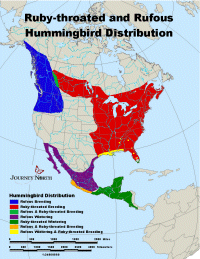|
Hummingbird Migration Update: March 23, 2006 |
Today's Report Includes:
| Hummingbird
Maps and Data |
Ruby-throated
Hummingbirds: Weather slowed the migration a bit; when you compare
the current map to the previous map, what do you notice? Which states are
now at the leading edge of the migration? It sounds like Rubythroat arrivals
are getting a good welcome: "Saw first one yesterday during a break
in the drizzle. Saw two fighting over my one feeder today. Will stop and
buy two additional feeders." (Austin, TX, March 20)
| Journaling
Question |
| Look
at the Rufous range map and also an atlas. What mountain range runs
through Oregon? How could elevation influence the Rufous hummingbird
migration? |
Rufous
Hummingbirds: The first Rufous report from Alaska has arrived!
“Good morning from spring in Juneau, where I have seen hummingbirds
on my way to work two days in a row: March 21 and March 22!” (Linda
Smith, Juneau, Alaska)
Meanwhile, why do you think this Oregon sighting includes a comment about
elevation?
“I put up a feeder three days ago. First sighting at 7:03 am on
March 22. Elevation is about 1500 feet in the coast range.” (McMinnville,
OR)
Challenge Question #5:
"The first Rufous has already reached Alaska, while Rubythroats are
clustered in Gulf Coast and southern states. Using clues throughout
this report, why do you think migration timing is so different
for these two species?"
To respond
to this Challenge Question, please follow these instructions.
|
"For
the past couple of days, we've seen female Rufous along with Anna's
collecting cotton/wool. We have an unusually large number of male
Rufous this year. We typically have the spring fly-through, where
the males come in numbers to the feeders, but it only lasts for
a couple of days. We still have at least a dozen male Rufous.
Combined with the Anna's and other hummingbirds, it’s probably
close to three dozen hummingbirds. We also have 17 feeders going
and 6 very large red-flowering currants that are covered with
flowers.” (Waldport, OR)
•How are these hummingbirds interacting with their habitat?
• Why do you suppose the female Rufous are collecting plant
fibers?
• Why do you think so many Rufous hummingbirds are attracted
to this observer’s yard?
|

Photo
Ray G. Foster |
| NEW!
Comparing Long-Distance and Short-Distant Migrants:
Link to Lesson |
Do you ever
see Ruby-throated hummingbirds in your yard in the winter? How about robins?
Ruby-throated hummingbirds are long-distance migrants;
they fly up to 2,000 miles between their wintering sites in Mexico and Central
America and their breeding sites in the U.S. and Canada. Robins, though,
are among the short-distance migrants. Robins migrate with
the seasons, but many remain in winter in the southern parts of their breeding
range. As the migration season unfolds, explore how the needs, adaptations,
and migration patterns of hummingbirds are intertwined. Our student record
sheet helps you organize your thoughts. You’ll be surprised at what
you discover as the season goes on. Why not start today?
| A
Sappy Subject and Something to Try |
Rufous hummingbird
migration appears timed to follow a “nectar trail” of blooming
flowers to fuel their migration. (You read about currant bushes covered
with flowers in the Rufuous observation above.) It’s different for
Rubythroats. Studies of Ruby-throated hummingbirds on migration have shown
that their journey north is NOT timed to match the peak blooming of flowers
to feed on along the way. In fact, ruby-throated hummers often arrive
in northern areas up to a month before many such plants have even begun
to bloom. How do they find enough food to get by? Like the rest of us,
hummers "get by with a little help from their friends." Who
are their friends? How do they help? How do hummingbirds return the favor?
Find out when you click on A
Partnership That Works.
|
|
The
tiny holes drilled by this Yellow-bellied Sapsucker are an important
source of sweet fluid for Ruby-throated hummingbirds in early spring.
|
 |
Try
This! Using binoculars,
look very carefully at the top branch tips of different kinds of
trees. Do you see any with tiny insects swarming at the newly running
sap? Can you find any birds up there?
|
|
Photo
Anne Cook
|
|
| A
Surprising Travel Tale: Discussion of Challenge
Questions #3 and #4 |

Photo
S. Sorenson |
Last time
we reported on a rufous hummingbird that wintered
in Indiana. Then we shared some hummer
facts and asked: What factors can you list that could explain this
Rufous sighting in Indiana? What factors could explain the overall increase
in Rufous sightings?
Some terrific seventh grade students at Iselin Middle School (New Jersey)
thought about the conditions hummingbirds need to survive. See what they
said, and then dig deeper with the additional thoughts of experts:
Discussion
of Challenge Questions #3 and #4
| The
Next Hummingbird Migration Update Will Be Posted on March *30, 2006
(* Migration Maps and Data Only). |
Copyright
1997- 2006 Journey North. All Rights Reserved.
Please send all questions, comments, and suggestions to our
feedback form.
 





|



![]()
![]()
![]()
![]()
![]()
![]()











